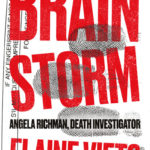As you know, writing dialogue is not for sissies. It has to sound believable, yet be informative and move your story’s plot forward.
This is hard to do. Recently, my editor called me on a clunky section of dialogue in Fire and Ashes, my second Angela Richman, Death Investigator novel. Angela works for the medical examiner in mythical, ultra-wealthy Chouteau Forest, Missouri. At a homicide, the death investigator is in charge of the body and the police handle the crime scene.
In my new novel’s first chapter, I tried to slip some important information into what was supposed to be casual dinner conversation between Angela and her colleague, Katie.
My editor caught me. She wrote: “Angela has lived in the Forest her whole life, right? This conversation with Katie seems a bit unnatural, like it’s only for the reader’s benefit (an ‘as you know, Bob’ conversation).”
Never mind what Angela said. It’s gone for good. But “as you know, Bob” dialogue – commonly called AYKB – is everywhere. It pops up on TV daily, and is especially popular in soap operas and medical dramas. Here’s an example:
Surgeon 1: “As you know, Bob, the patient is turning blue and choking, which could result in brain death unless the obstruction is removed from his mouth immediately.”
Surgeon 2: “Okay, I’ll take out his foot and he’ll still be able to run for election.”
 In novels, AYKB results in clunky dialogue like this:
In novels, AYKB results in clunky dialogue like this:
Dude 1: “Bunny is engaged to Esmeralda Gotrocks.”
Dude 2: “You mean the Massachusetts Gotrocks, who came over on the Mayflower?”
Dude 1: “The very same. Their great-grandfather owned Gotrocks Railroads, and in 1898 he married Adelaide Overbite, sole heir of the powerful oil family. Esmeralda’s father is Senator Gotrocks.”
Dude 2: “Good old Bunny. When’s the wedding?”
 Huh? There’s no need for those middle sentences about Esmeralda’s family. Everyone in those circles already knows it. That dialogue is there to let the readers know Bunny’s fiancee is rich and connected. AYKB dialogue states the obvious. It tells your readers what they need to know, but has nothing to do with what the characters need to know.
Huh? There’s no need for those middle sentences about Esmeralda’s family. Everyone in those circles already knows it. That dialogue is there to let the readers know Bunny’s fiancee is rich and connected. AYKB dialogue states the obvious. It tells your readers what they need to know, but has nothing to do with what the characters need to know.
Our own James Scott Bell in his book, Revision and Self-Editing (Write Great Fiction), warns about awkward information dumps. The key is to make your dialogue sound natural.
 I like the technique Nelson DeMille used in his thriller, Wild Fire, to deliver a lot of information. Detective James Corey and his wife, FBI Agent Kate Mayfield, are working to unravel a terrorism plot in the Adirondacks. They are city people and know nothing about this vast, wild area in the mountains.
I like the technique Nelson DeMille used in his thriller, Wild Fire, to deliver a lot of information. Detective James Corey and his wife, FBI Agent Kate Mayfield, are working to unravel a terrorism plot in the Adirondacks. They are city people and know nothing about this vast, wild area in the mountains.
DeMille has Corey driving on a nearly deserted mountain road, while Agent Mayfield reads him information they need to know about the park and the private land where the Custer Hill Club may be plotting to start nuclear Armageddon.
DeMille writes: “Kate had picked up a few brochures from the airport and was perusing them. She does this wherever we go so she can enhance her experience; then, she regurgitates this stuff back to me, like a tour guide.
 “She informed me that Saranac Lake, the town and the airport and this road, was actually within the boundaries of Adirondack State Park. She also informed me that this area was known as the North Country, a name she found romantic.
“She informed me that Saranac Lake, the town and the airport and this road, was actually within the boundaries of Adirondack State Park. She also informed me that this area was known as the North Country, a name she found romantic.
“I commented, ‘You could freeze to death here in April.’
“She went on, ‘Large parts of the park have been designated forever wild.’
“‘That’s pretty depressing.’
“The area designated as parkland is as big as the state of New Hampshire.”
You get the idea. DeMille is smart enough to make this a habit of FBI Agent Kate Mayfield. He delivered the brochure information without sounding like a brochure. You’ll have to read Wild Fire to find out if Mayfield and Corey save the world, but DeMille saved us from the dreaded AYKB.
 Brain Storm, the first Angela Richman, Death Investigator mystery, debuts August 2. Pre-order at http://tinyurl.com/hgbott5
Brain Storm, the first Angela Richman, Death Investigator mystery, debuts August 2. Pre-order at http://tinyurl.com/hgbott5


The CSI series used to be awful with this, although I think they cleaned up their act a tiny bit in later episodes.
Before I started (and will never finish) studying the craft, I loved Wilbur Smith’s stories. Stopped reading him during his book about elephants (that’s all I remember about the book; it had elephants in it) because he had two characters doing this:
Character A: You know that the earth revolves around the sun, right?
Character B: And the moon revolves around earth, of course.
Character A: And Pluto is now a planet again…
No conflict, unreal dialogue = boring.
The more I study the craft, the less tolerant I am of books that contain glaring weaknesses in the craft. I’ll read a good story that’s professionally written even if the author doesn’t really have a voice, but I prefer reading authors with voices and a solid understanding of the craft… I’d rather fill my head with examples of fine writing than read poorly written stories. The latter might be contagious!
So true, Sheryl. The dialogue in CSI was so cheesy.
Wanna be an editor? Or a reviewer? If only everyone had your high standards, Sheryl, AYKB would be a thing of the past, like those Victorian novels that began, “Dear Reader, it was the winter of 18–“
Before I buy a book I check the dialogue. Nothing ruins a story faster for me.
Dialogue is the key for me, too. Sue. I can’t read a book with clunky dialogue.
AYKB dialogue has been around from the beginning of daytime television where short skits were popular but didn’t have enough time to develop backstory to fill in the gaps. I still watch I Love Lucy reruns and this sort of thing doesn’t really bother me if done well, but as you mention, it must be done for a reason, not just to add to the plot.
I’ll just make up one:
Ethel: Bob Joe is coming into town tomorrow. You know, the guy who produced the Broadway hit “Your mama?”
Lucy: NO!
Ethel: Yes, and his daughter, Jeannie, remember her?
Lucy: Yes, the very talented ballerina with the clef lip.
Ethel: That’s the one! I heard she quit the show last week.
Lucy: Ethel, this is perfect. Remember when Ricky told me I’d never be on stage again?
Ethel: Of course I remember. Who could forget? He reminds me of my Uncle Tony. Boy, was he angry!
Lucy: Well wait til he finds out I’m going to be a ballerina! I’ll just have to convince Bob Joe I’m perfect for the part!
I think for skits and comedy, it’s fine. But I also hate this in a book because it requires too much of my brain time. Watching it on television doesn’t bother me. As a matter of fact, with Soap Operas, it used to get me back into the story when I’ve missed a couple of episodes. 🙂
AYKB is easier to take in a comedy skit. Good timing can overcome bad dialogue. In a book, you have to slog through it on your own.
Good points, Elaine.
I love DeMille’s John Corey series. The first person POV and internal monologue is what really makes them great.
Thanks for the post.
“The General’s Daughter” is a DeMille classic, Steve.
Great reminder, Elaine. I always say that dialogue is the fastest way to improve a manuscript … or sink it. I know editors who will skip ahead in a proposal to read some dialogue. If it’s sharp, orchestrated (characters don’t sound the same), full of snap and tension, the editor has great confidence this writer knows the craft. Eliminating “expository sneakage” is therefore essential.
“Expository sneakage” is my new favorite phrase, Jim. I love it.
Merck is currently running clinical trials for a new drug to treat expository leakage.
Great turn of phrase, Jim. Much classier than “info dump.”
Dialogue is so hard to get right and so important. Thanks for giving me a term AYKB for one annoyance. The other that troubles me is too stiff, too correct language in dialogue. I want proper usage in narration, but dialogue has to be more natural.
I can hardly wait for Brain Storm.
I have that battle with some copyeditors, Mary. They mean well, but they insist on correcting a character’s grammar. If the person is uneducated, their speech will not be correct.
PS: I can hardly wait for Brain Storm, either.
Argh. One of my pet peeves is dumb dialogue like this. Your AYKB is sad sibling to “Now I have to tell you why I must kill you, Bob” wherein the bad guy regurgitates his motives/backstory just before someone blows his head off and saves the day.
I also hate what I call “cop banter” where two guys in bad clothes (almost always guys, I don’t know why) do a running Abbot and Costello routine, usually holding coffee cups, as they stand over a corpse or something. I think writers do this in a quest for authenticity or “cop atmosphere.” Yeah cops joke, but geez, make it mean something to your story, please!
I don’t know where I heard this or who said it, but this is my single guiding principle about dialogue:
Say it uniquely or say something unique.
The rest is white noise.
“Say it uniquely or say something unique. The rest is white noise.” — good quote, Kris. I enjoy the Bond movies, but never did understand why the villains had to explain why they were going to kill Bond in various horrifying ways, except that it gave Bond time to escape and wrapped up the plot motivation. On the other hand, I’d love to fail on that level.
I was thinking about this more after I posted and realized — duh! — that screenwriters have a harder time than we novelists do because they can’t use exposition and graphs of narrative to “explain” how we got to a certain moment in a story. Everything has to be “on camera”…which sort of explains why Goldfinger gets so chatty when he aims the laser at Bond’s crotch. But the scene, cheesy as it is, is terrific, right? And it gave us one of the Bond franchise’s best exchanges:
Bond (as laser beam nears the family jewels): Do you expect me to talk?
Goldfinger: No, Mr. Bond. I expect you to die.
I remember one of the early Muppet movies where (I think) Diana Rigg looked into the camera and said something like, “Plot exposition, but we have to do it.”
LOL, Terry. If only we could get away with that.
Bond movies are a guilty pleasure, Kris. So bad they’re good. Or vice versa.
In romance, AYKB is “Maid-Butler” where the maid and butler gather in the pantry to refresh each other’s memories “You remember on Tuesday at ten a.m., that rainy day, when the reverend arrived on his black horse and told the master that his wife was dead.” type stuff.
I’ve found that it’s a lifesaver to have a ‘naive’ character in the scene so the cop can explain why he can’t get DNA in fifteen seconds, or what AFIS is. But it doesn’t always work.
Even harder is making sure that once you’ve brilliantly worked around the AYKB issues for Joe and Mary, that when Mary needs to tell Jane what she and Joe discussed, you don’t repeat the whole shebang all over again.
If the reader knows it, then the character shouldn’t repeat it, unless you can bring in new and important information.
Maid-butler is an old theater conceit, too. The curtain opens, and the phone rings. The butler answers, “No, the Richbodies are not at home. They’re expect to return within the hour. I will tell them you called, madam.”
I use the term explain-y.
I was talking with a friend and a fellow writer on this subject yesterday. My first experiences with story were as much from radio drama as they were from television and the artifice was often comical (and endearing in a nostalgic sort of way).
“I see you’re pointing that gun at my chest.”
“Yes, and it’s a 38 Colt and I still have four bullets left.”
“You’re standing three feet from me, so it’s not likely that you’ll miss.”
Of course, being on radio, the story had to say most everything by dialogue or narrative voice-over.
So, my rule of thumb is: don’t sound like you’re on the radio.
*A lot of great radio got around these strictures.
Good example, Martin. I’m going to an old-time radio play tonight in
Delray Beach. I’ll be on the lookout for explain-y dialogue.
Great examples! In Don’t Murder Your Mystery it’s called phony dialogue, and I’ve also heard it called pseudo dialogue. Sue Colletta’s method of checking dialogue before buying a book is SOP for acq. eds when considering whether an initially promising submission is worth shifting to a ‘maybe’ file. Jumping ahead to a visible stretch of dialogue often keeps the file from getting too full.